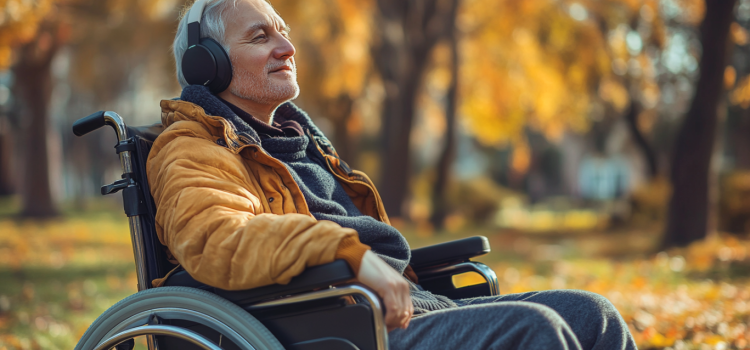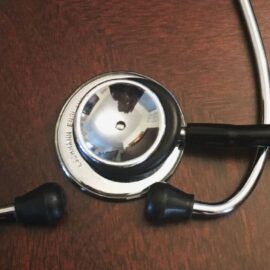
How can music help those with Tourette’s syndrome? How does music therapy work in the brain?
In his book I Heard There Was a Secret Chord, neuroscientist Daniel J. Levitin explains how music therapy can be a powerful medicine. He specifically mentions Tourette’s Syndrome, Parkinson’s, multiple sclerosis, and Huntington’s.
Continue reading to learn how to harness music as medicine for movement disorders.
Music as Medicine
In his book, Levitin goes on to explain that music is more than just a source of pleasure, emotional connection, and personal development. He argues that we should be using music as medicine. According to Levitin, music’s role in healing extends back at least 20,000 years, but, Levitins explains, there is now scientific research to support the medicinal power of music.
(Shortform note: Throughout history, many cultures have documented music’s role in healing practices. Ancient Egyptian medical texts provide some of the earliest documented examples of music in healing—the Edwin Smith and Ebers Papyri (c. 1500 BCE) describe the use of incantations and chants as part of medical treatments. Music also held an important place in ancient Greek healing practices. However, the systematic study and documentation of music therapy as a clinical practice didn’t emerge until much later, around the turn of the 19th century.)
Through clinical studies and patient case studies, Levitin shows how music can be harnessed to improve patient outcomes and quality of life in ways that complement traditional medical care. In Part 2 of this guide, we’ll explore practical applications of music for five types of conditions: movement disorders, mental health conditions, cognitive decline, chronic pain management, and neurodevelopmental disorders. Then, we’ll explore the future of music as medicine, and what further research is necessary.
Movement Disorders
According to Levitin, music therapy is a powerful intervention for people with movement disorders—conditions that impair motor control and fluency. Music therapy can help them because our brains are naturally wired to coordinate movement with sound. By having patients synchronize simple, repeated motions to steady rhythmic beats, music therapy strengthens the neural pathways essential for movement control.
(Shortform note: Some researchers suggest that using more complex musical stimuli, rather than simple rhythmic beats, may be more beneficial for people with movement disorders. Familiarizing patients with more sophisticated musical cues could lead to improved walking patterns and overall functioning compared to standard simple beats or unfamiliar music.)
Even more remarkably, these benefits extend beyond pure motor function. Through the principle of “embodied cognition”—which recognizes that physical movement is linked to how we learn and think—music therapy can enhance both motor control and cognitive abilities simultaneously.
(Shortform note: Music therapy is not the only treatment approach that leverages embodied cognition for rehabilitation. Virtual reality (VR) also can provide immersive, multisensory experiences that engage the whole body, promoting neural plasticity and motor learning. For those with movement disorders, VR-based interventions create safe, customizable spaces to practice complex motor tasks, receive real-time feedback, and simulate everyday activities.)
In this section, we’ll discuss specific musical interventions for the following movement disorders: Tourette’s syndrome, multiple sclerosis, Huntington’s disease, and Parkinson’s disease.
Tourette’s Syndrome
Tourette’s syndrome (TS) causes people to make movements and sounds they can’t control, which are called “tics.” These tics usually start during childhood, and often become less noticeable as people age. However, some people with TS find that their tics disrupt daily activities like reading, working, or socializing, and many experience physical discomfort or social anxiety due to their symptoms.
(Shortform note: TS affects roughly 0.6% of children, though estimates vary. CDC data shows only 0.3% of US children aged 3-17 received a TS diagnosis between 2016-2019, suggesting about half of cases may be undiagnosed. Boys are three to four times more likely to have TS than girls, and diagnosis rates are twice as high in children aged 12-17 compared to those 6-11. While TS occurs across all ethnic groups globally, some studies indicate higher rates in non-Hispanic white children. Tic disorders in general are more common, affecting approximately one in five children at some point.)
Levitin explains that music can help reduce tics, especially during activities like playing an instrument or dancing, which require focus and rhythm. He argues this works because Tourette’s disrupts normal brain wave patterns, and music helps reset them. The steady rhythms in music can synchronize brain activity, improving motor control and temporarily reducing tics.
(Shortform note: One study found that tics decreased when patients just imagined playing music in their heads. This likely works because thinking about playing music activates many of the same brain areas as actually playing. When patients mentally rehearse music, their brains engage motor planning regions—the parts that would control movement during real playing. This mental practice creates a pattern of brain activity that seems to temporarily override the urge to tic.)
Multiple Sclerosis
Multiple sclerosis (MS) affects the body’s nervous system, damaging the protective coating around nerve fibers. This damage disrupts messages between the brain and body, which can cause fatigue, make walking difficult, weaken muscles, and affect balance and coordination.
(Shortform note: MS affects approximately 1 million people in the United States and 2.9 million people worldwide. The prevalence varies by region, with higher rates in areas further from the Equator, potentially due to reduced vitamin D production from decreased sunlight exposure in these regions. MS also typically affects more women than men (2:1 ratio) and usually onset occurs around age 30. On average, MS reduces life expectancy by six to seven years, though this gap is narrowing as treatments improve.)
According to Levitin, rhythmic auditory stimulation (RAS) can help people with MS move more easily. The treatment is straightforward: Patients walk to music or a steady beat, which helps their brain and body get back in sync. Over time, this practice can improve their walking and balance.
(Shortform note: RAS is adaptable to different rehabilitation needs and settings. In home-based programs, patients can practice daily walking exercises to music selected to play at a tempo slightly faster than their natural walking pace, typically 10% above their normal cadence. Professional rehabilitation facilities integrate RAS into structured physical therapy sessions, allowing for supervised practice and immediate feedback. Additionally, emerging research explores the potential of wearable devices that deliver rhythmic cues, while also tracking and analyzing gait parameters, providing valuable data about patient progress and response to treatment.)
Levitin provides the example of Courtney Platt, a professional ballet dancer who performed with Ballet Arizona, but was best known for her appearance on Season 7 of So You Think You Can Dance. When Platt was diagnosed with MS at the age of 23, she was afraid it would end her dancing career. However, according to Levitin, by participating in RAS treatment regularly, she was able to maintain her balance and coordination despite her diagnosis. Practicing walking and moving to specific rhythms allowed her to manage her symptoms and continue dancing, eventually becoming both a performer and teacher while advocating for MS awareness.
(Shortform note: Since her MS diagnosis, Platt has maintained a career as a dancer, actor, and choreographer, appearing in productions like VH1’s “Hit the Floor” and “Grease Live!” while also teaching on-demand fitness classes for CLMBR. She’s become an advocate for MS awareness, partnering with organizations like the National Multiple Sclerosis Society and launching MS in Harmony, an online platform that provided interactive ways to explore music therapy for people living with MS, but no longer appears to be active.)
Huntington’s Disease
Huntington’s disease is an inherited condition that causes brain cells to break down over time, almost always proving fatal. People usually start showing symptoms in middle age, experiencing uncontrollable movements and severe declines in their thinking abilities and personality. As the disease progresses, they begin to lose their independence, requiring full-time care as they become unable to walk, speak, swallow, or care for themselves.
(Shortform note: Huntington’s disease (HD) is a relatively rare genetic disorder, affecting approximately 6.52 to 13.7 per 100,000 people worldwide. Traditional treatments for HD focus on symptom management, as there is currently no cure. These treatments include medications like tetrabenazine for involuntary movements, antipsychotics for severe irritability, and selective serotonin reuptake inhibitors (SSRIs) for obsessive-compulsive symptoms and milder mood issues.)
Levitin explains how a treatment called Huntington Speech Music Therapy (HSMT) combines music with speech exercises to treat the symptoms of the disease. Patients practice speaking while following musical rhythms and melodies, which can help them maintain clearer speech and better control of their movements. These exercises seem to help “rewire” the brain’s pathways, temporarily bypassing some of the damage caused by the disease. Though this treatment can’t stop the disease’s progression, it offers a way to help people maintain their abilities longer.
(Shortform note: HSMT works best during early to middle stages of Huntington’s disease when patients still have some control over their speech and movement. During these stages, the therapy can help maintain existing abilities and potentially slow the decline of speech and movement functions. As Huntington’s disease progresses to advanced stages, HSMT becomes less effective because patients develop more severe cognitive and physical impairments that make it difficult for them to participate in and benefit from the therapy.)
Parkinson’s Disease
Parkinson’s disease affects the brain cells that produce dopamine, a chemical that helps control movement. When these cells break down, people experience symptoms like tremors, stiff muscles, and difficulty with coordination, which can make daily activities challenging.
(Shortform note: Nearly 90,000 new cases of Parkinson’s disease are diagnosed annually in the US. By 2030, an estimated 1.2 million people in the U.S. will be living with Parkinson’s. Common treatments include medications like levodopa, which is the most effective and widely used therapy, as well as dopamine agonists and MAO-B inhibitors. Surgical options such as deep brain stimulation (DBS) and focused ultrasound (FUS) may benefit some patients. While there’s no cure for Parkinson’s, these treatments aim to reduce symptoms and enhance functioning.)
According to Levitin, music therapy has proven to be a powerful and customizable tool for managing Parkinson’s symptoms, with options ranging from walking exercises to singing and playing instruments. These treatments work in two ways: First, music’s steady beat acts as a timing device for the brain, helping patients achieve smoother movement, better stability, and improved coordination compared to traditional physical therapy alone. Second, music naturally triggers dopamine release in the brain, which can be so effective that some patients are able to reduce their medication doses when combining them with music therapy.
(Shortform note: Unlike traditional music therapy, which is often offered in clinical settings, some programs bring music therapy into patients’ daily lives. For example, the Ambulosono program offers an at-home approach to helping people with Parkinson’s disease. Patients wear a sensor (an iPod Touch with a special app) that plays music only when they take sufficiently long steps. This creates a simple reward system—take bigger steps and the music plays; take smaller steps and it stops. The program works by using the patient’s preferred music as a reward for better walking patterns and helping patients apply these improvements to daily life. The sensor also tracks progress precisely over time, making it easier to see improvements.)
However, music therapy doesn’t work for everyone, as evidenced by the experiences of musician Linda Ronstadt, diagnosed with Parkinson’s mid-career. Unlike some other musicians, Ronstadt has been unable to harness music as a source of relief. Her experience with the disease specifically impacted her ability to perform the repetitive motions necessary for singing, forcing her to stop performing.
(Shortform note: Since her diagnosis, Linda Ronstadt has become a powerful advocate for Parkinson’s disease awareness, using her platform to speak openly about her experience and champion the importance of research. Through media appearances and documentaries, she helps both musicians and the general public better understand Parkinson’s impact on people’s lives.)






